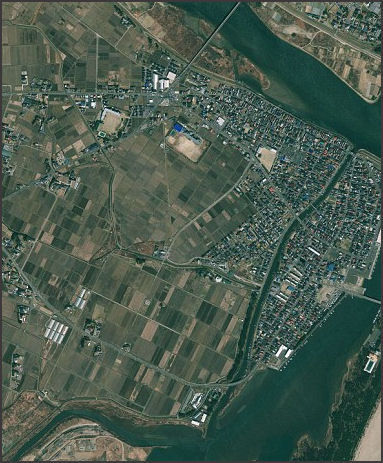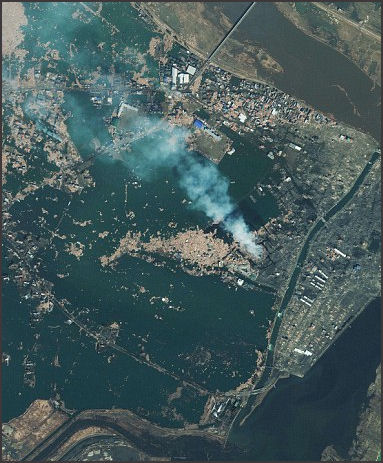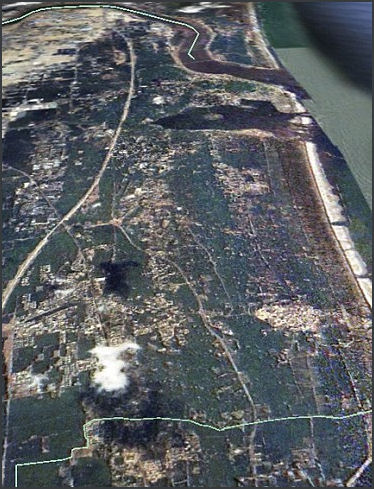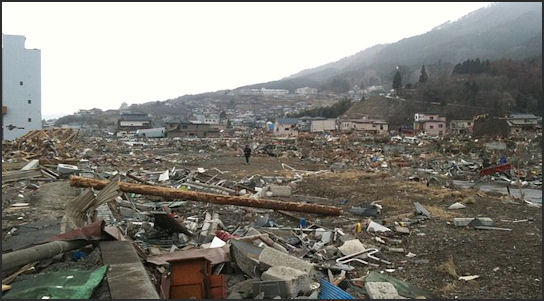TSUNAMI OF 2011 WIPES OUT MINAMISANRIKU

Natori Near Sendai Before In the coastal town of Minami-Sanriku, Miyagi Prefecture, most private homes and other structures were washed away. About 10,000 people, or more than half the total population, were killed. On the damage there CNN reported, “A family photo album lay on the sodden ground, showing a beaming man holding a newborn baby -- happiness out of place amid the devastation and carnage... Only a handful of buildings were left standing, with the rest a mangled mess of rubble. A boat sat on the edge of town, carried more than two miles inland by the tsunami.” [Source: Paula Hancocks, CNN March 14, 2011]
Reporting from Minamisanriku, Mark Magnier wrote in the Los Angeles Times, “Amid the unspeakable destruction that unfolded in just a few minutes during Friday's earthquake and tsunami, Minamisanriku stands out. An estimated 10,000 of its 17,000 people are missing and presumed dead, perhaps the most devastating toll in the disaster zone. “Most of those initially presumed dead escaped. In the end it was determined that of 17,000 residents in Minamisanriku, 1,000 were killed.[Source: Mark Magnier, Los Angeles Times, March 15, 2011]
“The roads, largely intact between twisted guardrails, suggest how the community was laid out, an ordered world of winding paths and oversized drainage canals meant to catch the runoff from steep mountains. The few houses that survived show the violence the region endured, with refrigerators shot through walls like bullets. In their midst, massive construction cranes lay overturned like kicked toys...Farther down the valley, 10 fire, rescue and hazardous material trucks were parked at the end of the only road into the community. A body lay in a pine casket under a blue tarp. The small number of bodies found and large number of missing have led authorities to conclude most were washed out to sea.”
In Sendai, the nearest city, Yoshiko Tsuzuki, a 55-year-old homemaker, was even more definitive about the fate of Minamisanriku. "It's been flattened, finished," she said, standing beside her husband and 16-year-old daughter. "I can't find my three sisters and parents in Minamisanriku. So many died, we can't find them and we're so anxious."
“Unlike the tangled debris seen at many other shore communities, Minamisanriku has a bleak emptiness, a silence that's replaced homes, schools and children playing. Heading up the plateau around a bend in the road, however, the houses are suddenly pristine, their flowerpots untouched, polished late-model cars in the driveway. But the residents have fled. "We've gone to Aramachi," said a paper sign on one house, listing the names of family members who have headed to a town far inland. The sight of the devastation below was apparently just too much.
So complete was the devastation and the reality that either you survived or you didn’t rescue workers were unable to find a single body or survivor after days of searching in the area. One rescue worker told Yomiuri Shimbun, “Although we’re reporting people are missing, it’s impossible even to locate the houses in which they lived.”
Links to Articles in this Website About the 2011 Tsunami and Earthquake: 2011 EAST JAPAN EARTHQUAKE AND TSUNAMI: DEATH TOLL, GEOLOGY Factsanddetails.com/Japan ; ACCOUNTS OF THE 2011 EARTHQUAKE Factsanddetails.com/Japan ; DAMAGE FROM 2011 EARTHQUAKE AND TSUNAMI Factsanddetails.com/Japan ; EYEWITNESS ACCOUNTS AND SURVIVOR STORIES Factsanddetails.com/Japan ; TSUNAMI WIPES OUT MINAMISANRIKU Factsanddetails.com/Japan ; SURVIVORS OF THE 2011 TSUNAMI Factsanddetails.com/Japan ; DEAD AND MISSING FROM THE 2011 TSUNAMI Factsanddetails.com/Japan ; CRISIS AT THE FUKUSHIMA NUCLEAR POWER PLANT Factsanddetails.com/Japan
Minamisanriku Survivors

Natori Near Sendai After Reporting from Minamisanriku, Mark Magnier wrote in the Los Angeles Times, “Mitsuko Koshi, 82, and Shizuka Hoshi, 65, were also among the lucky. The two women were in their shared home Friday afternoon when the earthquake hit. As a precaution, they headed for higher ground. Their house was located along the narrow valley, which concentrated the full force of the torrent that sucked away houses, cars and trees. The two decided to climb up to a small Shinto shrine on the hillside, said builder Teiichi Fujiwara, 63, Koshi's son and Hoshi's son-in-law. [Source: Mark Magnier, Los Angeles Times, March 15, 2011]
Even then, the water came up to their waists. Only by grabbing onto a tree and holding tight were they able to survive. Then as the water receded, they walked two hours to a standing structure. Fujiwara searched the area for days, finally finding them Tuesday at City Hall. "There's no way they'd have survived if they lived down there," Fujiwara said, pointing toward the beach. "You go 10 miles in every direction and there are no people left."
When the tsunami warning sounded Friday, "Most people ran away," said Choushin Takahashi, who was working in a local government office near the water, told CNN. "Some had to leave the elderly or disabled behind on the second floor. I think a lot of those left behind probably died." As the wave hit, he said he felt as if it was happening in a dream. "I saw the bottom of the sea when the tidal wave withdrew and houses and people were being washed out," another resident said. "I couldn't watch anymore." Three days later, 42 people were pulled out of the rubble alive.
Running for One’s Life and Seeking Refuge of an Office Roof in Minamisanriku

Sendai before Reporting from Minamisanriku, Martin Fackler and Michael Wines wrote in the New York Times, “Yasumasa Miyakawa, 70, who owned a laundry on the first floor of his home, said he and his wife ran up a hill when they heard the tsunami warnings. Then Mr. Miyakawa went back down, because he forgot to turn off his iron and was afraid it would catch fire. [Source: Martin Fackler and Michael Wines, New York Times, March 15, 2011
When he stepped back outside his shop, he heard those on the hill above him yelling: “Run!” A wave was barreling at him, about a half-mile away, in the bay, he said. He jumped in his car, and by the time he could turn the key and put it in gear, the wave was almost upon him. He said he sped out of town chased by the wave, rising in his rearview mirror. “It was like one of the ridiculous scenes from an action movie, except it was real,” said Mr. Miyakawa, his hands quivering. “I was going 70 kilometers per hour, or about 45 miles per hour — and the wave was gaining on me. That’s how fast it was.”
When he returned the next morning, he found his home reduced to its foundations, and heard faint cries for help. He followed them to a nearby apartment building, where he found a woman shivering and wet in the March cold and took her to a shelter. “The wave killed many,” he said, “but it spared a few.”
Among them were the town’s children, whose schools were located safely on a hilltop. In fact, the children said they did not even notice the wave. Ryusei Tsugawara, a 13-year-old middle school student, said he figured something was amiss only when school ended and teachers would not let the children go home. Instead, the children were kept at school until the next day, when his parents and those of some of the other children began to claim them. Some parents never showed, and the unlucky children have been placed in care of friends and relatives, town officials said. “The town is gone, and I’m scared to stay here,” Ryusei said.
A decision to gather on the roof of the town hall proved fateful for many. Mr. Sato, the mayor, said he and other town employees rushed to watch the approaching wave from the roof, which at three stories high and a half-mile from the shore seemed safely out of harm’s way.
Instead, Mr. Sato said, the water roared up to the building and swept over its roof, pinning him against a steel railing, with his head just above water. He said that was the only reason he survived. Of the 30 people on the roof, only 10 survived by clinging onto the railing or an antenna. After the waters receded, Mr. Sato and the other shivering survivors on the roof collected the splintered boards and Styrofoam to build a fire. The next morning, they used some fishing rope to climb down. About 7,500 survivors have gathered in shelters on hilltops, where they remain without electricity, heat or running water, waiting for help from the outside.
“Surfing” on the Flood in Minami-Sanrikucho
“Fifty-six-year-old firefighter Junnosuke Oikawa and five or six of his colleagues were swallowed up by the tsunami floodwaters quickly roiling up to the ceiling of the second floor of their workplace in Minami-Sanrikucho, Miyagi Prefecture,” the Yomiuri Shimbun reported. "I thought to myself, 'I can't make my wife a widow; I have to survive for my family,'" said Oikawa, recalling when the water nearly engulfed him. [Source: Yomiuri Shimbun, March 30, 2011]
“He said the tsunami came at about 30 kph and pushed him about 500 meters. Then the backwash dragged him toward the sea for about two kilometers. Oikawa heard roaring and rattling sounds, and saw cars and gas cylinders in the water. He grabbed a nearby pillar to raise himself up to get a breath of air. Then the next wave hit him. Oikawa reacted by swiftly holding wooden posts in both hands and pulling them together to his chest, managing to ride out the wave in a way akin to surfing.”
In his childhood, Oikawa said, he used to tie a plank to his waist to ride the waves for fun at the nearby beach. "It was popular [among kids growing up] in a seaside town. If I hadn't known to do that, I would've been swallowed up by the water," Oikawa said. He was rendered unconscious a bit, but was rescued in the town's Togura district, about five kilometers south from where the tsunami first hit him. "Tsunamis are a killer. I thought I died many times," Oikawa said.
Trapped in a Car During the Tsunami in Minamisanriku

Sendai After Reporting from Minamisanriku, Miyagi Prefecture, Mark Magnier wrote in the Los Angeles Times,”Looking back, Emiko Chiba has no idea how long her silver Suzuki rode the waves of a giant tsunami or even whether she had trouble breathing inside of it. What's clear is that she ranks among the very lucky in what may be Japan's most unfortunate town.[Source: Mark Magnier, Los Angeles Times, March 15, 2011]
“Chiba was in her car Friday afternoon when the tsunami slammed into this small farming, fishing and beach community. As the mountain of water hurtled up a narrow valley, the Suzuki somehow was lifted up rather than plowed beneath its waves. Another resident found the 42-year-old shaken and battered, and walked with her for an hour to the nearest standing house, where her husband, Kazahiro, eventually found her.”
“Among the dead is Kazahiro's mother. His father is missing. On Tuesday, Emiko and Kazahiro found their car in the debris field. They took a blue pail, a black thermos, an umbrella, a sun visor and a windshield scraper they'd scrounged from the car and headed back out of the valley. Emiko has been unwilling to sleep. She looked shellshocked, barely lifting her eyes above the ground, her face grim and dark. “It's like a bad dream,” said Kazahiro. “It's a nightmare.”
Surviving and Finding Shelter in Minami Sanriku
From a safe shelter in Minamianriku, Miyagi Prefecture one the hardest hit areas by the March 11 tsunami, Sachie — the mother of one-year-old Kouka — told World Vision Japan: “Kouka was having a nap in the house when the earthquake occurred. I took Kouka right away and ran out side, but the earth was shaking for quite a long time...[The ocean] was quickly overflowing and the tsunami was approaching toward us. As I saw the size of the tsunami, I instinctively realized I wouldn’t survive if I stayed inside. So I carried Kouka again, and ran up the hill as fast as I could. When I reached the top of the hill, I saw my house was washed away by tsunami.” [Source: Katsumi Takagi, World Vision Blog, March 23, 2011]
“It was snowing that day and was very cold. I stayed the night outside with 13 other neighbors. I had no more diapers for Kouka. But one of the neighbors had a toilet sheet for her pet, and she gave it to me. So I used it on top of Kouka’s diaper.” Food was in short supply, too. “When an elderly person saw and found Kouka hungry, she gave me a candy,” adds Sachie. “I chewed and broke this candy and gave it to Kouka.”
“When the dawn came, fire department officers came to rescue us. We were frightened that tsunami might come again, so we moved on quickly. I took off the sandals I was wearing, and walked down the railway sleeper with my socks. Kouka, on my back was marching with me saying, “one two, one two” as I walked...We walked all the way until we could see the rescue bus, and I think it was about 4 o’clock that afternoon when I finally arrived [at the] shelter...I am so grateful.” Upon their arrival, Sachie received milk and diapers provided by World Vision for Kouka to use. They were also offered hot soup.”We adults, can bear without meals and clothes for a couple of days. But it is really difficult for small children without milk and diapers. So it was very helpful that diapers were supplied in this shelter. Thank you very much. I lost my house, possessions and everything else, but I am so grateful that everyone is helping us.”

Rikuzentakata
Dogs Search for the Dead in Minamisanriku
South Korea had dog rescue teams in Japan within a days after the earthquake. Dog teas from other countries arrived soon after that. Reporting from Minamisanriku, Mark Magnier wrote in the Los Angeles Times, “A few hundred yards up the valley road, three dog teams from Swiss Rescue, a search group sponsored by the government of Switzerland, worked an area of debris on the north side of the valley. Japan waived its quarantine requirement for animals to let the dogs in.” [Source: Mark Magnier, Los Angeles Times, March 15, 2011]
“Each dog works just 20 minutes while the two others rest. "Smelling so intensely is hard work," said group leader Linda Hornisbergen. These canine units are trained to unearth the living. “There's no hope really of finding someone alive here,” she said. “But the Japanese want us to look for the dead.”
“The team found three spots amid the rubble they believe may harbor bodies, and pointed them out to government officials. It is also important to determine which areas are clear of bodies so authorities can go ahead with cleanup and reconstruction. The dogs can detect bodies 60 to 100 feet away depending on wind, soil and moisture conditions. The mud is dense and wet after the tsunami and Tuesday's rain, hardly ideal conditions for the dogs' noses.”
Search and rescue efforts were frequently disturbed by tsunami alerts prompted by ongoing aftershocks. When the alarm sounded, police abandoned their cars, rescue workers blew whistles and people rushed to high ground. "It's your life!" shouted one man. "Run!" It was a false alarm, but such warnings are taken seriously in the wake of the disaster. [CNN]
Image Sources: 1) U.S. Navy; 2) NASA; 3) Mitsukuni Sato
Text Sources: New York Times, Yomiuri Shimbun, Daily Yomiuri, Washington Post, Los Angeles Times, Kyodo News, National Geographic, The Guardian. Times of London, The New Yorker, Time, Newsweek, Reuters, AP, AFP, and various books and other publications.
Last updated October 2011
